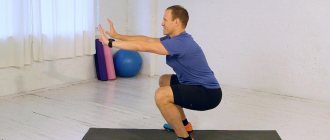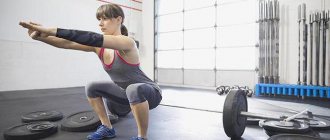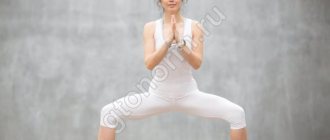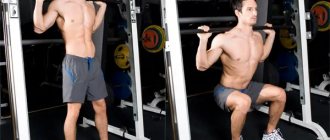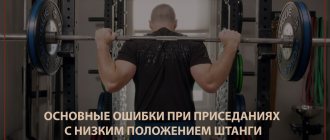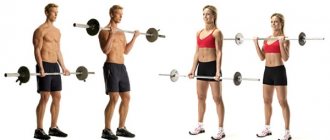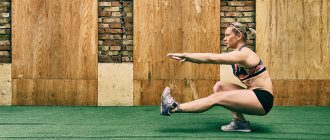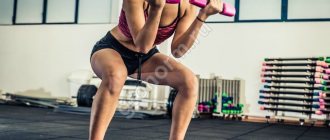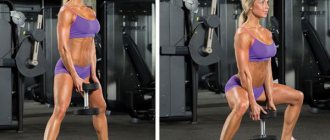Content
- 1 Workout squats
- 2 Sequential exercises on both legs 2.1 Squats supported on a bench
- 2.2 Squats with vertical support
- 2.3 Squats
- 2.4 Squats with narrow legs
- 2.5 Squats with wide stance
- 2.6 Prison squats
- 2.7 Split squats
- 2.8 Walking lunges
- 2.9 Bulgarian split squats
- 2.10 Indian squats
- 2.11 Calf raises
- 2.12 Archer squats
- 3.1 Single leg stand
What muscles work?
During Indian push-ups, significantly more different muscle groups are involved than with classical push-ups. However, the load on them is distributed more evenly, which somewhat reduces the effectiveness of this exercise as a basic one.
| Muscle group | Load type | Accent |
| Breasts | Main active | Significant |
| Pectoral bundles | Additional active | Small |
| Triceps extensor | Main active | Significant |
| Psoas muscles | Additional active | Small |
| Core muscles | Additional active | Small |
| Abdominal muscles | Main active | Significant |
| Front delts | Main active | Significant |
| Upper deltas | Main active | Significant |
| Rear delts | Additional active | Absent |
| Biceps flexor arm | stabilizing | Absent |
| Forearm muscles | Main active | Significant |
| Psoas muscles | Stabilizing | Absent |
| Trapezoidal | Stabilizing | Absent |
| Quadriceps | Main active | Significant |
| Calf | Main active | Significant |
Workout squats[edit | edit code]
You can't be strong if your legs are weak. Dot. Without strong pillars to support your body, you cannot navigate the world with confidence. Anyone can knock you down. You won't be able to be on top.
Although the squat is the most basic lower body exercise in calisthenics, it is far from the only one of its kind. Next, we will tell you about many exercises that, in fact, are not squats. However, for organizational reasons, this section includes all exercises that focus on the legs.
Squats
is a unique exercise because it works both the front and back of the legs. Squats primarily involve three joints: the hip, knee, and ankle. The muscles of the back of the thighs and buttocks are involved in the movement of the hips, the quadriceps straighten the leg at the knee, and the calves are responsible for the movement of the lower legs. Squats also work your tibia muscles, hip flexors, lower back muscles, abdominal muscles, etc. That's right - squats work every muscle in your lower body and more. What's more, they can be endlessly adapted to suit different fitness levels.
These exercises are grouped into two categories: exercises for both legs and exercises for one leg. Before moving on to variations involving one leg, practice the exercises on both legs well. Workout squats can be complicated or simplified in an infinite number of ways to suit both the most experienced athlete and the beginner.
Contraindications and harm
Unlike the axial loads that occur during lower and upper back exercises, Indian push-ups are memorable for their ability to help recover from injury. And most importantly, they do not have any specific contraindications, except:
- The presence of severe muscular dystrophy;
- The presence of a prolapsed hernia;
- Kyphotic curvature of the spine;
- Diseases associated with the gastrointestinal tract;
- Postoperative periods when working with the abdominal muscles;
- Hypertension.
The only harm these push-ups can do is increase the pressure. And then, this is only possible if you seriously disturb your breathing technique during the exercise.
Consecutive exercises on both legs[edit | edit code]
Double leg squats are the basics. Every primate in the animal kingdom squats. In fact, human babies learn to squat before they even learn to walk. For most squats, it is recommended to place your feet flat on the floor. This helps to maximally target the glutes and hamstrings, but as you'll see, there are many variations on this basic bodyweight exercise, although there are exceptions to every rule.
Squats with support on a bench[edit | edit code]
If you're new to squats, you can use a step, bench, or any other elevated platform to help you perform the exercise. Simply stand with your back to the object and sit on it with your feet flat on the floor and your arms extended forward for balance. If you lose your balance, there will be an object underneath you to rest on, which will prevent you from falling. Over time, you will become more in control of the downward movement. Finally, you will be able to move on to lower subjects. Gradually you will learn to squat all the way without support.
Squats with vertical support[edit | edit code]
Vertical support is another easy way to use external objects for support in a workout if you have balance and/or mobility issues when squatting. Stand facing a pole (or door, or any other strong object that you can lean on). Gently lean on it and squat down, slowly lowering your arms as you lower your body down. Try to pause at the bottom of the exercise, as this gives the necessary stretching load, then return to the starting position, helping yourself with your hands if necessary.
Squats[edit | edit code]
Stand tall with your feet shoulder-width apart. Brace your core and squat down, bending your hips, knees, and shins to lower your butt toward your heels. This will be easier to do by keeping your arms out in front of you as you lower down, and keeping your head and chest straight to maintain balance. Try to lower your hips below your knees before returning to the starting position. Ideally, your calves should be pressed against your hamstrings at the bottom of a squat. Try not to hunch over and make sure your heels don't leave the floor.
Some people will find it easier to perform the exercise with their feet on the ground parallel to each other, while others find it more convenient to spread their feet slightly apart. Either way, make sure your knees move in the same plane as your toes. Don't let them screw in or stick out to the sides.
The whole truth about flexibility
For many people, flexibility is the hardest part of performing a full range of squats. If you have difficulty going down, we recommend that you spend more time in the lowest position you can achieve. It is helpful to place your elbows between your thighs to create the desired leverage. With time and practice, you will be able to open your hips wider, allowing you to perform a deep squat.
Narrow leg squats[edit | edit code]
Main articles:
Narrow squats and Closed squats
Workout squats with a narrow stance put stress on the outer thighs. The narrower your feet are, the more flexibility you need in your hips, hamstrings, and calves to get into the bottom position. Some people don't have the flexibility to squat all the way down.
Squats with wide stance[edit | edit code]
Different leg positions engage muscles differently during a squat. Wide stance usually places stress on the buttocks and inner thighs. She also teaches hip stretching. Try placing your feet at different widths and see what is more comfortable for you.
Prison squats[edit | edit code]
Prison squats are a slightly more challenging variation of standard squats in which you place your hands behind your head with your fingers crossed rather than holding them in front of you or at your sides. As you begin to lower into the squat, you will likely feel your chest muscles stretch due to the change in arm position. Pull your shoulder blades down and back to make it easier to maintain proper body position. You will be surprised how much this exercise makes itself felt in the lower back. This exercise also makes it more difficult to maintain balance.
Split squats[edit | edit code]
In this variation, you start the exercise in a position with one leg in the back and the other in front. The back leg is bent and resting on the toe, while the forward leg is flat on the floor.
Keeping your torso straight, lower yourself until your knees are bent at about a 90-degree angle, then return to the starting position.
You can try starting the movement by pushing off with your back foot so as not to lean too far forward. Your center of mass should be between your two legs and your weight should be evenly distributed across your legs.
Walking lunges[edit | edit code]
Starting position: standing. Take a large step forward, then gently lower the knee of your back leg until it almost touches the floor. Keep your forward leg fully flat on the floor and your back leg bent, allowing your heel to lift up, the same position as in the bottom phase of a split squat. From this position, rise up and step forward, bringing your legs together, then perform another repetition on the opposite leg. Walking lunges can also be done backwards to make the exercise more challenging.
Bulgarian split squats[edit | edit code]
Main article:
Bulgarian squats and lunges without weights
Get into a split squat position by placing one foot back on a step, bench, or other object. Place your front foot on the floor a few inches in front of your hips. Bend both legs, lowering the knee of your back leg towards the floor, then return to the top phase of the exercise.
Raising your back leg during a split squat changes your body's leverage and the weight each of your legs lifts, which requires more power from your forward leg while also stretching the back leg's hip muscles. The higher the elevation, the more intense the exercise becomes.
Indian squats[edit | edit code]
Indian squats are squats that are specifically performed on the toes. While it's recommended to first master standard squats with your heels on the floor, Indian squats can be a good choice once you've developed enough leg strength. By rising onto your toes, you can place more emphasis on the front of your thighs and also introduce a unique element of balance to the exercise.
Calf raises[edit | edit code]
Main article:
Standing calf raise
Stand on a step or any other elevated surface with your heels hanging down. Keeping your toes pressed into the surface and your calves tense, rise all the way up onto your toes. Return to the starting position and repeat the exercise. To make the exercise more challenging, try doing it on one leg!
Archer squats[edit | edit code]
Main article:
Roll squats
Start in a squat position with your feet very wide so that your toes point out to the sides. Slowly shift your body weight to one leg and begin to squat, keeping the other leg straight.
As you approach the ground, roll onto the heel of your extended leg so that your toes point up. This exercise will also help you stretch the muscles in your groin and/or inner thighs. Keep your abdominal muscles tight and be sure to press the heel of your working leg toward the ground the entire time.
Execution technique
Before you begin, warm up well, especially paying attention to your spine. The first thing you need to do to perform Indian push-ups
is to take the standard position for most push-ups while lying down, with your hands positioned slightly wider than your shoulders. Then pull your feet towards your palms until your pelvis is raised, as shown in the figure, while your legs and back should not bend. This is the starting position. Start lowering your torso, pushing it forward as if you are overcoming an invisible obstacle. When your hips drop, use your arms to push your torso up. At the end, lower your torso while raising your hips - this is one repetition. If it is difficult to perform this type of push-up, place your hands on a small hill.
Sequential single-leg squat exercises[edit | edit code]
One of the biggest misconceptions about calisthenics strength is that there is a limit to how intense you can train your legs.
When it comes to different variations, it is important to train both legs evenly. One way to achieve this is to alternate legs with each new repetition: left-right-left-right, etc. Another method is to perform the entire set on the weaker leg first. This way you can give your weak leg more attention by training it while you are still fresh, full of energy and know that you can do the same number of repetitions on your strong leg.
Single leg stand[edit | edit code]
At first glance, it seems like there's nothing special about it, but a simple one-legged stand can be surprisingly challenging if you do this exercise for a long time. Start with ten seconds on one leg and gradually increase the duration of the single leg stand. The higher you hold your raised leg, the more difficult it is to perform the exercise.
Standing on one leg can give a good workout to the small muscles in the feet and legs that we often forget about.
Stepping[edit | edit code]
Stand in front of a step, bench, or any other solid object that is approximately knee height. Raise one knee and plant your entire foot firmly on the object. Step up and press your heel into the floor until your leg is completely straight. Return back to the starting position and repeat the exercise.
Swallow[edit | edit code]
Stand on one leg, raising the other off the ground behind you. Begin to lean forward at the hips, trying to reach the toes of your extended leg with your fingers, keeping your body straight from your heel to the back of your head. You will have to use your lower back muscles as you need to keep your torso and extended leg parallel to the ground. This exercise will help you stretch the muscles in the back of the leg on which you stand. Returning to the starting position, tense your core muscles, while trying not to twist your body as you lift it. You can keep your hands at your sides or put them behind your head to make the exercise more difficult.
Pistol squats supported on a bench[edit | edit code]
Main article:
Pistol squats
Stand with your back to a bench or any other knee-high object. Raise one leg, extend your arms forward, and sit gently on the bench (with a double-leg variation of this exercise, it's okay if you feel off-balance at first). Pause briefly in the lower phase of the exercise, then, pressing your heel into the floor and tensing your core and abdominal muscles, rise to a standing position, maintaining your balance.
Pistol squats with emphasis on a bench are a good introduction exercise for those who have never done the full pistol exercise.
Pistol squats with vertical support[edit | edit code]
As with the two-legged vertical squat, stand facing an object (a door or any other solid object that you can lean on). Holding it lightly, lift one leg. On your other leg, lower yourself into the bottom of the squat, moving your arms lower as you lower down. Use your arms to support yourself as much as you need to maintain your balance, lower yourself down and help yourself to the starting position. Over time, you will learn to rely less on your hands. Finally, you will no longer need support at all. Pistol squats with a vertical support are another great way to make it easier for you to perform a full range of pistol squats.
Pistol squats on a raised surface[edit | edit code]
Stand on a bench or other object with one leg dangling. Stretch your arms forward and slowly squat down on one leg; the second leg should go below the bench.
When the free leg hangs parallel to the body, it creates more leverage and good stability compared to a regular pistol squat. It also requires less flexibility in the hips and hamstrings. The lower you lower your free leg, the less mobility is required. Once you can do a few clean reps, try holding your free leg a little higher. Finally, you'll be able to hold it high enough to do pistol squats on the ground.
Pistol squats[edit | edit code]
There are many types of single leg squats, but the pistol squat is a classic. It perfectly combines strength, balance, flexibility and stability.
In the starting position, lift your straightened leg, then squat as low as possible on your supporting leg. Pause briefly in the lower phase, keeping your abdominal muscles tense, then return to the upper phase.
Don't be surprised if you notice that your free leg is also tense during pistol squats. You'll have to engage the hip flexors and quadriceps muscles on that side of your body to keep your leg in the air. The term "single leg squats" can be misleading.
Wushu style pistol squats[edit | edit code]
If you've spent a little time doing pistol squats, at some point your free leg may cramp because you've been working hard to keep it in the air. To avoid this, many people find it helpful to hold the toe of their free foot, especially at the bottom of the exercise. This exercise is also suitable for those who have difficulty keeping their free leg straight. This variation is often called wushu style pistol squats. By holding your toe, you also create tension throughout your entire body.
Advanced pistol squats[edit | edit code]
Once you've developed enough strength and balance to perform a few regular pistol squats, get better at it. If you find it too easy to do pistol squats with your arms extended, try placing your hands behind your head like a prison squat. And when this becomes too easy, try putting your hands behind your back. This simple change in leverage will make the exercise much more difficult.
Exercise "pistol" on the rail[edit | edit code]
Performing the pistol exercise while standing on a rail or bar takes the balance component to a whole new level. The narrower the rail, the more difficult it is to perform the exercise, so first try working on a relatively wide rail and gradually move on to a narrower one.
Dragon squats[edit | edit code]
Dragon squats are similar to standard pistol squats, with the only difference being that the extended leg is now passed under the working leg.
Like traditional pistol squats, dragon squats require serious strength, balance and mobility, but in a slightly unusual way. You'll be surprised how much this variation can work the muscles in your inner thighs, as well as the deep muscles in your buttocks and thighs. And, of course, all the muscles that the pistol exercise trains are involved in this variation.
As with standard pistol squats, working from an elevated surface and/or holding the foot of your free leg with your hand is a great way to make it a little easier to perform the full range of dragon squats.
Hanging Lunges[edit | edit code]
Hanging lunges are single-leg squats where the free leg is positioned in the back instead of in front as in a pistol squat. They look almost like split squats or lunges, except the back leg doesn't touch the floor (hence the name "hanging lunge"). However, unlike lunges, you will have to extend your arms in front of you and lean your body forward to maintain balance due to the fact that your back leg does not touch the floor. As with many squat variations, you may want to hold on to a pipe or other stable object to help you balance at first.
Shrimp squats[edit | edit code]
Shrimp squats (also known as skater squats) are a more challenging hanging lunge variation in which you hold your shin behind your back with your hand. By placing your hand behind your back, you change the leverage, thus increasing the difficulty of the exercise. The exercise also involves more elements of balance and flexibility. Stand on one leg with one shin behind your back. Begin to sit down slowly on your opposite leg, lowering your back knee down until it touches the floor behind the heel of the leg you're standing on.
You will have to lean forward to maintain balance at the bottom of the exercise. As you push off the ground with your working leg, returning to the upper phase of the exercise, tighten your abdominal muscles. It can also be helpful to try pressing your backward leg toward your arm to create additional tension.
It's not uncommon for people new to this exercise to fall the first time they try it, so you may need to place something soft under the knee of your free leg when you try this exercise for the first time. once.
Advanced shrimp squats[edit | edit code]
Like pistol squats, you can make shrimp squats much harder by placing both hands behind your back. This nuance may not seem significant at first glance, but it can make this exercise much more difficult. Be sure to lower yourself slowly so as not to hit the floor with the knee of your back leg. To get both arms behind your back, you may also need to lean further forward to create the necessary counterbalance.
Havana squats[edit | edit code]
While pistol squats require flexibility in the hamstrings and shrimp squats require the quadriceps and hip flexors to work through a full range of motion, Hawaiian squats require incredible flexibility in the rotator cuff and hip muscles.
To perform Hawaiian squats, place one leg on your knee, then squat as low as possible on the leg you're standing on. Again, you can begin the exercise by holding onto a sturdy object or sitting on a bench for stability if necessary.
As we've seen with other workout squat variations, it will be easier to work with your arms extended forward than if you put them behind your head. The most difficult exercise is to do with your hands behind your back.
King prawn squats[edit | edit code]
Unlike pistol squats, which are easier to perform on an elevated surface, performing shrimp squats on an elevated surface will increase the range of motion because you will now have to lower your knee below your feet. An expanded range of motion can significantly complicate an already quite complex exercise.
King prawn squats also require greater flexibility due to the increased range of motion. You may have to move your knee forward a little as it approaches the elevated surface you are standing on.
Plyometric matrix. Jumping[edit | edit code]
Any type of jumping is a plyometric exercise. When jumping, it is useful to push off your feet from the floor surface as hard as possible in order to jump up as high as possible.
The plyometric element can be applied not only to squats, but to almost any variation of squats, including split squats, lunges, step-ups, pistols, and just about anything else you can imagine.
As you land, bend your legs at the hips, knees, and shins to absorb the impact of the ground. This leg workout will immediately engage a huge number of muscle fibers, and it is also a cardio exercise, since it will require a huge flow of blood to the largest muscle in the body.
Historical reference
Since childhood, Frederick C. Hatfield (there is also a variant spelling of the surname Hatfield) was fond of various sports: running, American football, basketball. After serving in the army, he attended Southern Connecticut State University, where he studied gymnastics and competed at national championships. In 1969, Hatfield successfully completed his studies with a bachelor's degree in physical development and rehabilitation. In 1973 he received a doctorate in sports psychology and sociology.
After graduation, he taught for several years at universities throughout America. At the same time, Hatfield did not forget about sports. He was professionally fond of weightlifting, but, not making it into the country's Olympic team, he switched to powerlifting. In the 80s, he decided to leave his professorship and go into business. His passion for strength training helped him found a company that produces sports equipment and food products.
Powerlifting brought Hatfield fame. At the age of 45, the already middle-aged athlete was able to squat 1014 pounds (460 kg), setting an absolute record. Moreover, Frederick’s weight at that time was 115 kg.
Thanks to his achievements in strength training, he was given the popular nickname "Doctor Squat." After this, Hatfield increasingly began to be invited as a consultant and coach at various sporting events.
During one of his workouts, Frederick severely injured his shoulder joint, which meant a long recovery period and a refusal to squat with a barbell. The athlete was thinking about how to continue training without aggravating the injury. After several attempts, he managed to create a bar for safe squats.
The projectile made it possible to balance the load on the musculoskeletal system and free the shoulders. Subsequently, the exercise was called “Hatfield squats.”
Add an elastic band to increase the force
As you approach the top of the rep (lifting the barbell), the tension releases a little. Thus, while the load at the bottom may be severe, it may not be sufficient at the top as the legs reach full extension. To redistribute the load and flatten the force curve a little, use a sports elastic band.
The band will provide logical resistance and also accelerate you on the way down (which will also have to be fought through muscle tension). Choose the load according to your goals. Using an elastic band can be a good option for improving endurance-speed (high output load and rate of force development).
